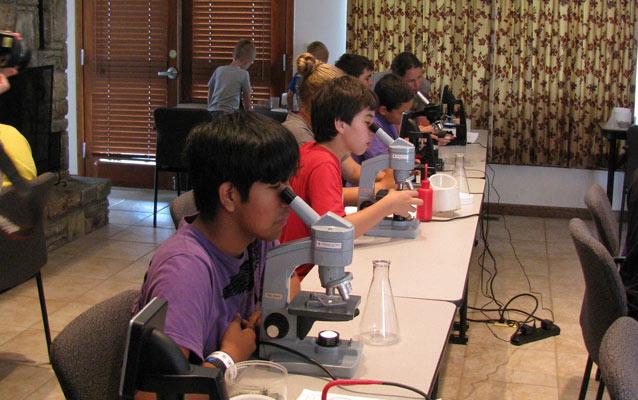Lesson Plan

NPS Photo - Susan Sachs
- Grade Level:
- Sixth Grade-Eighth Grade
- Subject:
- Biodiversity, Biology: Animals, Earth Science, Ecology, Environment, Science and Technology
- Duration:
- 30 minutes
- Group Size:
- Up to 60
- Setting:
- classroom
- National/State Standards:
- North Carolina Essential Standards Grade 7 Science 7.L.1.2
- Keywords:
- biodiversity, all taxa biodiversity inventory, ATBI, extremophile, tardigrade, meiofauna, Great Smoky Mountains National Park
Overview
In this lesson students will be introduced to the microscopic world that thrives in lichens including Tardigrade characteristics, the Great Smoky Mountains National Park’s All Taxa Biodiversity Inventory and man-made threats. This unit is broken into three parts including a trip to the park, a preparation activity and two wrap-up activities. This is the field preparation activity of the unit.Objective(s)
1) understand the biodiversity of the Great Smoky Mountains National Park
2) learn several characteristics of Tardigrades
3) explain what is meant by an extremophile
Background
There is a microscopic world around us that few people are fortunate enough to explore. In this unit, we will discover the hidden world inside a collection of lichens. Using a simple lab extraction method, we will isolate Tardigrades, Rotifers, Nematodes, Water mites and possibly other creatures. This activity pairs well with our Lichen Monitoring study and both units together explore the impacts of acid deposition on lichens and the fascinating world that lies within.
This lesson specifically introduces students to Tardigrades and the terminology used to describe them.
Teachers coming on the accompanying field trip should download our complete field trip packet that includes this Tardigade Research Preparation pre-site lesson, information and directions about the field trip and the Tardigrade Research Wrap-up post-site lessons.
Download the full Tardigrade Field Trip Packet here (includes Preparation and Wrap-up lessons).
Link to the Tardigrade Research Preparation lesson
Link to the Tardigrade Research Wrap Up Part 1 and Part 2 lessons
Materials
Students will be introduced to Tardigrades and the All Taxa Biodiversity Inventory in Great Smoky Mountains National Park via two information worksheets.
Tardigrade information worksheet
ATBI and Tardigrade worksheet
Computer with internet connection
-
Tardigrade information sheet
This sheet contains some student background information on Tardigrades. It should be read over by students before their field trip to the Smokies. Download
-
Tardigrade and ATBI information sheet
This information sheet for students introduces them to the All Taxa Biodiversity Inventory in Great Smoky Mountains National Park. It focuses specifically on the Tardigrade inventory. Download
Procedure
Step 1: When students visit the Smokies on their field trip they will be collecting, isolating, and viewing tardigrades. This lesson will introduce tardigrades and their characteristics. Read aloud to the students the following information regarding the ATBI and Tardigrades. Students should read individually the vocabulary and definitions worksheet and tardigrade information worksheet. After the students have finished their reading, discuss the characteristics of tardigrades and what adaptations they have in order to live in extreme environments.
Step 2: To view the Biodiversity podcast video go to
http://www.thegreatsmokymountains.org/eft/10modules.html Turn the microscope knob that appears on the computer screen to Section 1, Understanding Biodiversity. Click "Watch Video" and view video.
Assessment
Students can create a concept map for the subject of "tardigrades" before starting the series of lessons. They can create a second concept map for comparison after the lessons. Did students show any gains in their organization of their knowledge; the use of concepts, content and terminology and connections; and knowledge shown between the relationships of concepts. Please see our concept map scoring rubric for grading guidance.
Park Connections
When most students imagine national parks and nature in general they probably think of large animals such as bear and deer. Although bear, deer, and other visible animals are important parts of the ecosystem, there are other important pieces that we often overlook. Tardigrades and other microorganisms are some of the most numerous and most biodiverse organisms on Earth. This unit explores the biodiversity of these microscopic organisms and the threats to some of their preferred habitats.
Vocabulary
Bilateral symmetry: symmetrical arrangement, as of an organism or a body part, along a central axis, so that the body is divided into equivalent halves.Cryptobiosis: the metabolic state some organisms enter in response to adverse environmental conditions such as freezing, drying, or oxygen deficiency. In this state, all metabolic processes stop, preventing reproduction, development, and repair until environmental conditions return to being hospitable. When this occurs, the organism will return to its metabolic state of life as it was prior to cryptobiosis.
Eutardigrada: a class of Tardigrada without lateral appendices. These species are primarily found in lichens, mosses, and leaf litter, but many species are found in freshwater habitats such as lakes, rivers, and streams.
Extremophile: an organism that thrives in and even may require physically or geochemically extreme conditions that are detrimental to the majority of life on Earth.
Heterotardigrada: a class of tardigrades comprised of two orders: the armored terrestrial tardigrades and the marine tardigrades. Heterotardigrades have a lateral appendage between the head and the shoulder plate.
Meiofauna: animals inhabiting the bottom of a river, lake, or sea that are nearly invisible to the naked eye with dimensions in the range 0.1 to 1 mm.
Micrometazoa: extremely small multicellular animals.
Parthenogenesis: form of reproduction in which an unfertilized egg develops into a new individual; no males are present in the population.
Polyextremophiles: an organism which has several extremophilic features.
Tun: cryoptobiotic state of the tardigrade in which the appendages are drawn inward and metabolism stops.
Last updated: April 14, 2015
